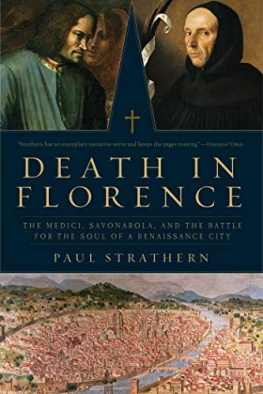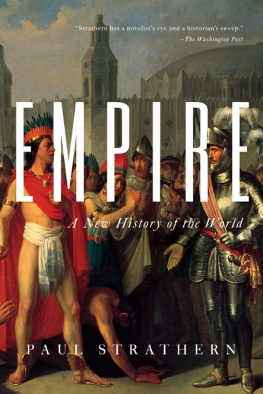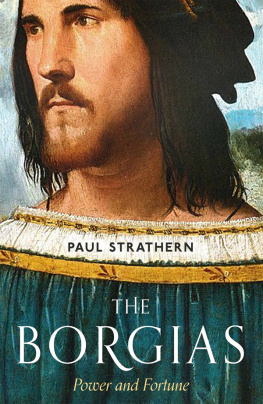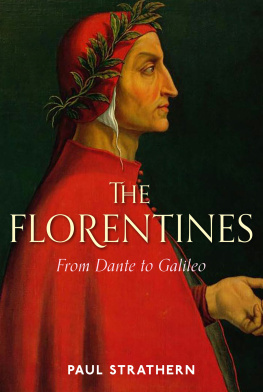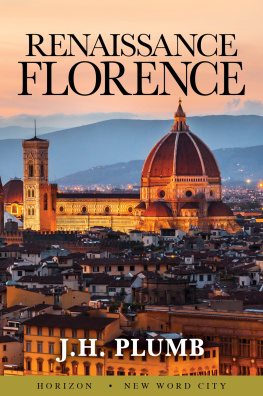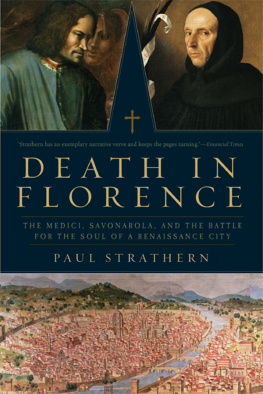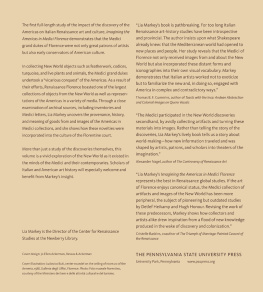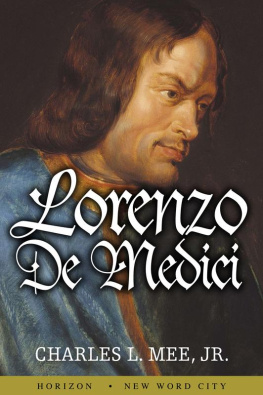Contents
Ordeal by Fire
About the Book
By the end of the fifteenth century, Florence was well established as the home of the Renaissance. As generous patrons to the likes of Botticelli and Michelangelo, the ruling Medici embodied the progressive humanist spirit of the age, and in Lorenzo the Magnificent they possessed a diplomat capable of guarding the militarily weak city in a climate of constantly shifting allegiances between the major Italian powers.
However, in the form of Savonarola, an unprepossessing provincial monk, Lorenzo found his nemesis. Filled with Old Testament fury and prophecies of doom, Savonarolas sermons reverberated among a disenfranchised population, who preferred mediaeval Biblical certainties to the philosophical interrogations and intoxicating surface glitter of the Renaissance. Savonarolas aim was to establish a City of God for his followers, a new kind of democratic state, the likes of which the world had never seen before. The battle which this provoked would be a fight to the death, a series of sensational events invasions, trials by fire, the Bonfire of the Vanities, terrible executions and mysterious deaths featuring a cast of the most important and charismatic Renaissance figures.
This famous struggle has often been portrayed as a simple clash of wills between a benign ruler and religious fanatic, between secular pluralism and repressive extremism. However, in an exhilaratingly rich and deeply researched story, Paul Strathern reveals the paradoxes, self-doubts and political compromises which made the battle for the soul of the Renaissance city one of the most complex and important moments in Western history.
Also by Paul Strathern
The Artist, The Philosopher and The Warrior
Napoleon in Egypt: The Greatest Story
The Medici: Godfathers of the Renaissance
Dr Strangeloves Game: A History of Economic Genius
Mendeleyevs Dream
Philosophers in 90 Minutes
The Big Idea: Scientists Who Changed the World
List of Illustrations
Contemporary portrait of Savonarola by his friend Fra Bartolomeo. Florence, Museo di San Marco. 2010. Photo Scala, Florence courtesy of the Ministero Beni e Att. Culturali.
Portrait bust of Lorenzo de Medici, probably after a model by Andrea del Verrocchio and Orsini Benintendi. Palazzo Medici-Riccardi, Florence, Italy/The Bridgeman Art Library.
Portrait of Piero de Medici by Angelo Bronzino (150372). Private Collection/The Bridgeman Art Gallery.
The Carta della Catena showing a panorama of Florence, 1490. Museo de Firenze Comera, Florence, Italy/Alinari/The Bridgeman Art Library.
Portrait of Alexander VI. Vatican, Pinacoteca. 2010. Photo Scala, Florence.
Portrait bust of Charles VIII, King of France (c.14831498). Museo Nazionale del Bargello, Florence. Alinari Archives, Florence.
Portrait of Pico della Mirandola by Cristofano dell Altissiomo (c.15251605). Florence, Galleria degli Uffizi (Gioviani Collection). 2010. Photo Scala, Florence courtesy of the Ministero Beni e Att. Culturali.
Portrait of Angelo Poliziano (14851490). Detail of a fresco of the sacrifice of the prophet Zechariah, by Domenico Ghirlandaio in the Main Chapel of the Church of Santa Maria Novella in Florence. Alinari Archives, Florence.
Portrait of Marsilio Ficino. 2010. White Images/Scala, Florence.
Savonarola preaching. 2010. Photo Ann Ronan/Heritage Images/Scala, Florence.
Self-portrait of Sandro Botticelli. Detail from Adoration of the Magi . Florence, Galleria degli Uffizi. 2010. Photo Scala, Florence courtesy of the Ministero Beni e Att. Culturali.
The Birth of Venus by Sandro Botticelli (14451510). Florence, Galleria degli Uffizi. 2010. Photo Scala, Florence courtesy of the Ministero Beni e Att. Culturali. Botticellis illustration to Dantes Divine Comedy c.1480. Berlin, Kupferstichkabinett, Staatliche Museen zu Berlin. 2010. Photo Scala, Florence/BPK, Bildagentur fr Kunst, Kultur und Geschichte, Berlin.

The Medici Family Tree

Leading Dramatis Personae and Main Factions
Alexander VI notoriously corrupt Borgia Pope who became Savonarolas sworn enemy Alfonso, Duke of Calabria son and heir of King Ferrante I of Naples. Would later become Alfonso II of Naples Anne of France acted as Regent during the youth of Charles VIII Arrabbiati the most powerful anti-Savonarola faction Bigi faction supporting return of Piero de Medici Sandro Botticelli renowned painter and friend of Lorenzo the Magnificent Fra Pacifico Burlamacchi wrote early biography of Savonarola, much of it heard from Savonarola himself Piero di Gino Capponi leading Florentine citizen who famously defied Charles VIII Cardinal Caraffi of Naples friend of Alexander VI who nonetheless supported Savonarola Ser Ceccone (real name Francesco de Ser Barone) Savonarolas chief civil interrogator Charles VIII the young King of France who invaded Italy Compagnacci fanatically anti-Savonarola group led by Doffo Spini Commines (Commynes) leading adviser of Charles VIII who kept a diary Cardinal della Rovere sworn enemy of Alexander VI, who encouraged Charles VIII to set up a council to depose him Bartolomeo Cerretani contemporary Florentine chronicler Domenico da Pescia the Dominican monk who was Savonarolas closest and most loyal supporter, who followed his master to the end Lucrezia Donati the most beautiful woman in Florence, to whom the young Lorenzo the Magnificent addressed love poems Ferrante I King of Naples who received Lorenzo the Magnificent Marsilio Ficino celebrated Platonist and close friend of Medici family Francesco da Puglia a Franciscan monk from Santa Croce and a bitter enemy of Savonarola who issued the challenge for the ordeal by fire Battista Guarino the celebrated humanist scholar whose lectures Savonarola attended at the University of Ferrara Francesco Guicciardini contemporary historian of Florence and Italy Fra Leonardo da Fivizzano Augustinian monk at Santo Spirito who preached in Florence against Savonarola when he was at the height of his power Giovanni della Vecchia the Captain of the Square, responsible for keeping the peace in the Piazza della Signoria, and later at San Marco Giovanni Manetti the Arrabbiati responsible for stirring up the crowd at the ordeal by fire, who later demanded permission to inspect Savonarola Niccol Machiavelli contemporary historian of Florence and Italy Fra Malatesta (Sacramoro) the Arrabbiati spy in San Marco Domenico Mazzinghi pro-Savonarolan gonfaloniere who later argued in favour of the ordeal by fire Fra Mariano da Genazzano the Augustinian who was Florences favourite preacher before his contest with Savonarola Cosimo de Medici the man who built up the Medici bank, grandfather of Lorenzo the Magnificent Giovanni de Medici second son of Lorenzo the Magnificent, who became a young cardinal Giovanni di Pierfrancesco de Medici taken into the Palazzo Medici by his uncle Lorenzo the Magnificent as a youth when his father Pierfrancesco died. Giuliano de Medici Lorenzo the Magnificents younger brother, who was murdered Lorenzo de Medici (Lorenzo the Magnificent) effective ruler of Florence until 1492 Lorenzo di Pierfrancesco de Medici son of Pierfrancesco de Medici. Taken into the Palazzo Medici as a youth when his father died Lucrezia (ne Tornabuoni) de Medici Lorenzo the Magnificents influential mother Fra Ludovico da Ferrara despatched to Florence by Alexander VI to investigate Savonarola Fra Silvestro Maruffi monk at San Marco prone to visions who would follow Savonarola to the end Pierfrancesco de Medici cousin of Piero de Medici and grandson of Giovanni di Bicci, the founder of the Medici bank Piero de Medici first son of Lorenzo the Magnificent who took over his rule of Florence in 1492 Dietisalvi Neroni long-term business associate of Cosimo de Medici, who grew jealous of Piero de Medici Clarice (ne Orsini) de Medici Lorenzo the Magnificents Roman bride Pico della Mirandola charismatic Renaissance philosopher, befriended by Lorenzo the Magnificent, his biography was written by his nephew, Francesco Pico della Mirandola Piero Parenti Florentine diarist during this period Piagnoni Savonarolas supporters, mainly drawn from amongst the poor, but extending into all sections of Florentine society Angelo Poliziano renowned poet and member of Lorenzo the Magnificents circle Bishop Remolino finally despatched by Alexander VI to conduct Savonarolas examination Bernardo Rucellai leading Florentine citizen sent by Lorenzo the Magnificent on delegation to persuade Savonarola to tone down his sermons; later turned against Peiro de Medici (the Unfortunate) Girolamo Rucellai moderating voice at the Pratica called to debate the ordeal by fire Marcuccio Salviati commander of the pro-Savonarolan troops at the ordeal by fire Girolamo Savonarola the Dominican friar who stood against all that the Medici represented Michele Savonarola Girolamos grandfather and a formative influence. Despite being a pioneering physician, he remained a strict medievalist. Niccol Savonarola Girolamos unsuccessful father Galeazzo Maria Sforza nephew of Ludovico Sforza, and rightful heir to the Dukedom of Milan Ludovico il Moro Sforza uncle of Galeazzo Maria Sforza, who acted as ruler of Milan during his nephews minority Paolantonio Soderini leading citizen and supporter of Savonarola Doffo Spini the headstrong leader of the Compagnacci extreme anti-Savonarola faction Giovanni Tornabuoni Lorenzo the Magnificents uncle, manager of the Rome branch of the Medici bank Fra Mariano Ughi the second Dominican who volunteered for the ordeal by fire Francesco Valori sent by Lorenzo the Magnificent on a delegation to warn Savonarola to tone down his sermons; later pro-Savonarolan gonfaloniere Simonetta Vespucci celebrated at the age of 17 as the most beautiful woman in Florence. Lorenzo the Magnificents brother Giuliano is said to have pined for her love
Next page
